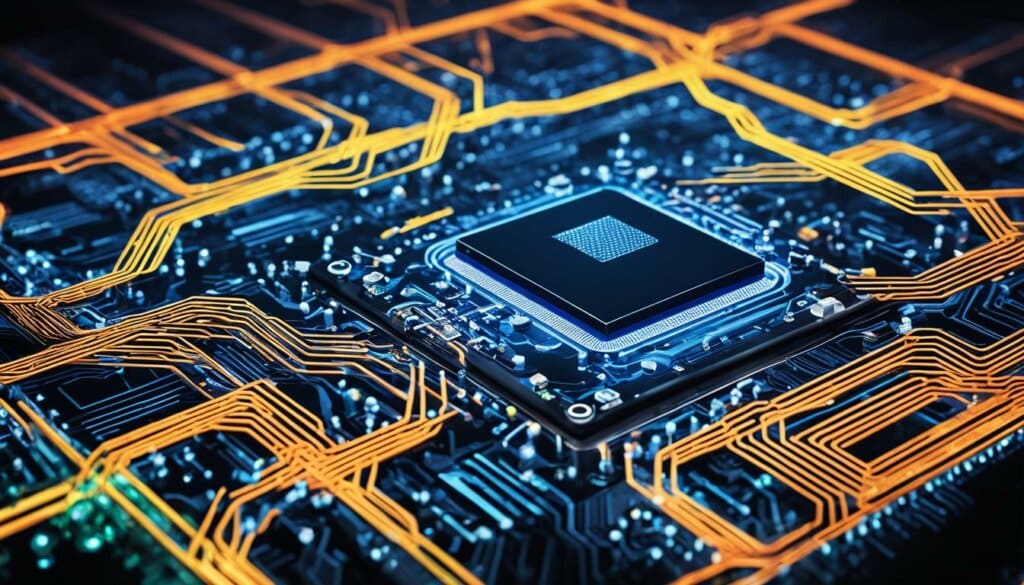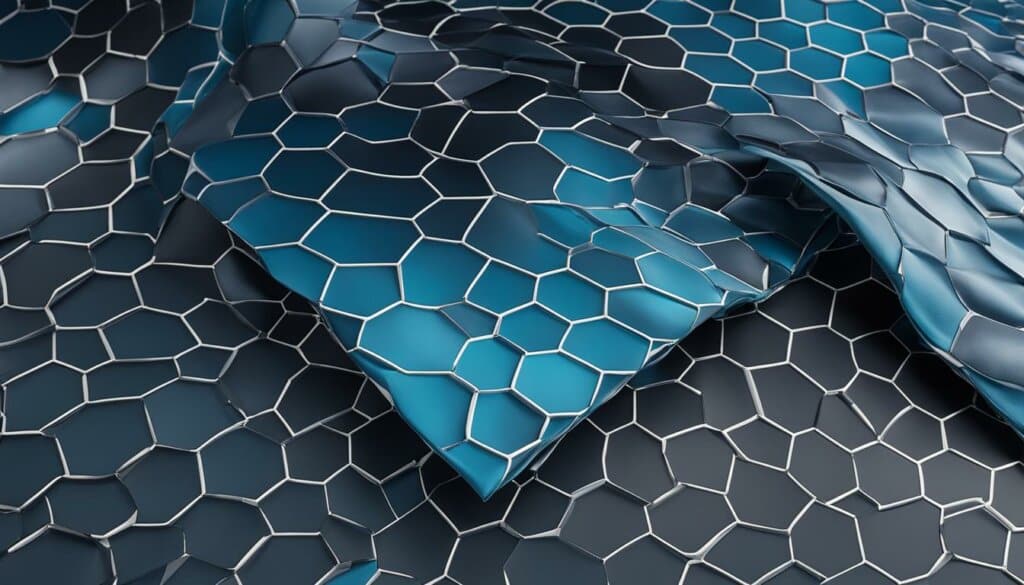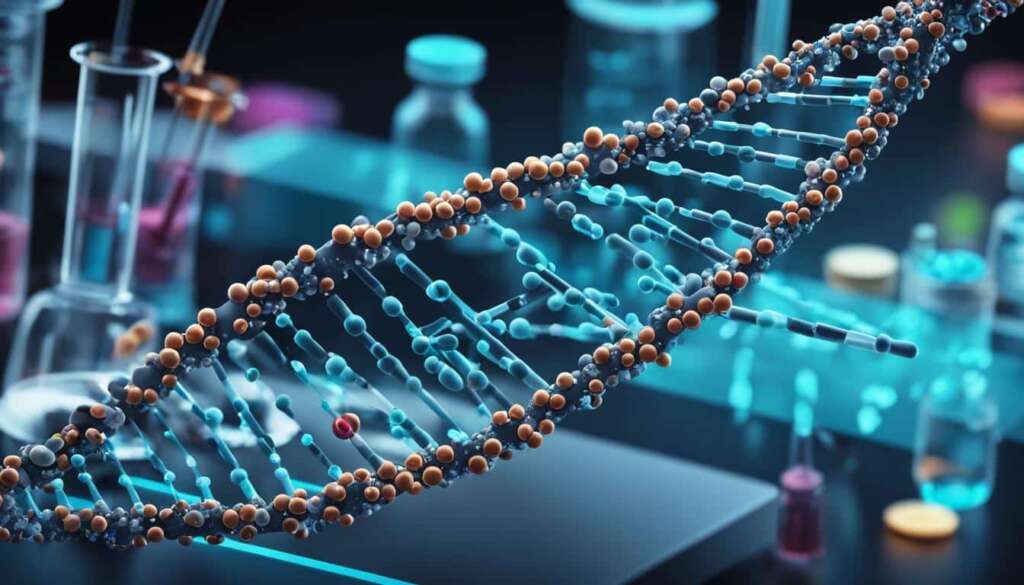Table of Contents
Nanotechnology, the manipulation of matter at the nanoscale, has revolutionized various industries and brought about significant innovations and applications. From electronics and energy to biomedicine and textiles, nanotechnology has transformed the way we design and create materials, devices, and systems. By harnessing the unique properties and behaviors of particles at the nanoscale, scientists and engineers have developed groundbreaking solutions and materials with enhanced functionalities and improved performance.
Key Takeaways
- Nanotechnology offers innovative solutions and materials with enhanced properties.
- Examples of nanotechnology applications can be found in electronics, energy, biomedicine, environment, food, and textiles.
- Nanotechnology has the potential to revolutionize industries by providing smaller, faster, and more efficient components.
- Nanomaterials in biomedicine enable early diagnosis and targeted drug delivery.
- Nanotechnology contributes to environmental sustainability through air and wastewater purification.
Types of Nanotechnology
Nanotechnology is a diverse field that encompasses various approaches and techniques. Let’s explore the different types of nanotechnology, including top-down, bottom-up, dry nanotechnology, and wet nanotechnology, each with its unique characteristics and applications.
Top-Down Nanotechnology
Top-down nanotechnology involves the miniaturization of larger structures and mechanisms to the nanoscale. It focuses on breaking down materials and systems into smaller components. This approach enables precise control and manipulation of nanostructures, paving the way for advancements in fields such as electronics, photonics, and materials science.
Bottom-Up Nanotechnology
Bottom-up nanotechnology takes a different approach by starting from nanoscale structures and building larger systems through self-assembly. This method harnesses the inherent properties of nanomaterials to create complex structures and devices. Bottom-up nanotechnology has applications in fields like medicine, optics, and energy storage.
Dry Nanotechnology
Dry nanotechnology refers to the use of non-aqueous environments while working with nanomaterials. It involves the manipulation and fabrication of materials like coal, silicon, metals, and semiconductors. Dry nanotechnology plays a crucial role in the development of electronics, sensors, and advanced manufacturing processes.
Wet Nanotechnology
Wet nanotechnology, on the other hand, utilizes biological systems and operates in an aqueous environment. It takes inspiration from nature and leverages biological processes to create new materials and devices. Wet nanotechnology finds applications in healthcare, biotechnology, and environmental engineering.
These different types of nanotechnology offer a wide range of possibilities for scientific and technological advancements. Understanding their unique characteristics allows researchers to tailor their approaches and applications accordingly, leading to groundbreaking discoveries and innovations.
Image:
Nanotechnology in Electronics
Nanotechnology has propelled the field of electronics to new heights, ushering in significant advancements. By harnessing the power of nanomaterials, electronics manufacturers are revolutionizing the industry with smaller, faster, and more efficient components.
One of the most promising nanomaterials in electronics is carbon nanotubes. These cylindrical structures exhibit extraordinary electrical conductivity and mechanical durability, making them ideal candidates to replace silicon in microchips and electronic devices. With their smaller sizes and higher efficiency, carbon nanotubes offer the potential to enhance the performance of electronic circuits.
Another groundbreaking nanomaterial is graphene. Known for its exceptional strength, flexibility, and electrical conductivity, graphene is a single layer of carbon atoms arranged in a two-dimensional arrangement. Its unique properties make it an excellent candidate for the development of flexible touchscreens. These innovative touchscreens can be bent, folded, and rolled up without sacrificing performance.
“Nanotechnology enables the creation of electronic components that are not only smaller but also more powerful and versatile. With carbon nanotubes and graphene at the forefront of these advancements, the electronics industry is poised to enter a new era of innovation.”
By harnessing the potential of nanotechnology, electronic devices can become more compact, energy-efficient, and capable of delivering enhanced functionalities. From nanoscale transistors to quantum nanowires, the applications of nanotechnology in electronics are vast and transformative.
Let’s have a closer look at some of the key applications of nanotechnology in electronics:
- Carbon Nanotubes in Microchips: Carbon nanotubes offer the potential for smaller, faster, and more energy-efficient microchips. With their exceptional electrical properties, these nanomaterials can replace traditional silicon and enable the production of advanced electronic devices.
- Graphene in Flexible Touchscreens: Graphene’s exceptional flexibility and electrical conductivity make it an ideal material for flexible touchscreens. These graphene-based touchscreens can be incorporated into wearable devices, foldable smartphones, and other next-generation electronic gadgets.
- Quantum Nanowires for Quantum Computing: Quantum nanowires, which are ultra-thin nanowires that exhibit unique quantum properties, hold great promise for the development of quantum computing. These nanowires can serve as the building blocks of qubits, the fundamental units of information in quantum computers.

As nanotechnology continues to advance, the possibilities for further integration into the electronics industry are boundless. The potential to create smaller, more efficient, and more powerful electronic devices is driving researchers and manufacturers to explore the frontiers of nanotechnology.
Nanotechnology in Energy
Nanotechnology has made significant contributions to the energy sector, revolutionizing the efficiency and sustainability of various energy sources. By harnessing the unique properties of nanomaterials, researchers have developed innovative solutions to enhance solar panels, wind turbines, and fuel efficiency in energy-intensive applications.
Solar Panels
One remarkable application of nanotechnology in energy is the improvement of solar panels. Scientists have developed a new semiconductor material that increases the efficiency of solar cells by doubling the conversion rate of sunlight into electricity. This breakthrough technology allows solar panels to produce more energy using the same amount of sunlight, making solar energy a more viable and cost-effective solution.
To achieve this, researchers have engineered nanostructures within the solar cell that trap light and improve its absorption. These nanostructures, such as quantum dots or nanowires, enable solar panels to capture a wider range of light wavelengths, including ultraviolet and infrared, thus maximizing energy conversion.
Wind Turbines
Nanotechnology has also played a crucial role in enhancing the efficiency and durability of wind turbines. By incorporating nanocomposites into the manufacturing process, wind turbine blades can become stronger, lighter, and more resistant to wear and tear. This improvement allows wind turbines to generate more energy while enduring harsh environmental conditions.
Furthermore, the application of nanocoatings to wind turbine surfaces reduces friction and turbulence, enabling smoother airflow over the blades. This optimization enhances the energy extraction from the wind, leading to increased power generation.
Fuel Efficiency
Nanotechnology has the potential to significantly improve fuel efficiency in various energy-consuming applications. By incorporating nanocomponents with thermal insulation properties, such as nanosized ceramic particles, heat transfer can be minimized, reducing energy loss and optimizing fuel consumption.
Additionally, nanoparticles can be used as catalysts in combustion processes, ensuring more complete and efficient fuel combustion. This approach maximizes energy output while minimizing harmful emissions, contributing to both energy efficiency and environmental sustainability.
In conclusion, nanotechnology has revolutionized the energy sector by enhancing the efficiency of solar panels, improving the performance of wind turbines, and optimizing fuel efficiency. These advancements not only increase the availability of sustainable energy sources but also contribute to a greener and more environmentally friendly future.
Nanotechnology in Biomedicine
Nanotechnology has revolutionized the field of biomedicine. Through the use of nanomaterials, significant advancements have been made in early diagnosis and targeted drug delivery for diseases like cancer and neurodegenerative disorders.
One of the key benefits of nanotechnology in biomedicine is the ability to selectively target cancer cells without harming healthy tissue. This targeted approach allows for more effective and less invasive treatments, improving patient outcomes and quality of life.
Furthermore, nanotechnology has been utilized to enhance pharmaceutical products such as sunscreen. Nanoparticles in sunscreen can provide better protection against harmful UV rays, offering greater benefits in terms of sun protection and skin health.
“Nanotechnology has opened up new possibilities in early diagnosis, targeted drug delivery, and cancer treatment.” – Dr. Emma Johnson, Biomedical Researcher
This table provides an overview of key applications of nanotechnology in biomedicine:
| Application | Description |
|—————————-|——————————————————————————————–|
| Early diagnosis | Nanosensors and nanoparticles can detect biomarkers and biological changes for early diagnosis of diseases. |
| Targeted drug delivery | Nanoparticles and nanocarriers can deliver drugs directly to specific cells or tissues, improving treatment efficacy and reducing side effects. |
| Cancer treatment | Nanotechnology enables targeted therapies, including photothermal therapy, gene therapy, and immunotherapy, for more effective cancer treatment. |
| Neurodegenerative disorders | Nanotechnology offers potential solutions for targeted drug delivery and regeneration of damaged neurons in disorders like Alzheimer’s and Parkinson’s. |
Nanotechnology in the Environment
In the pursuit of environmental sustainability, nanotechnology has emerged as a valuable tool. Its applications extend to various aspects of environmental preservation, including air purification, wastewater treatment, and the development of efficient nanocatalysts for chemical reactions.

Air Purification
Nanotechnology has paved the way for innovative air purification methods that go beyond traditional filters. The generation of ions through nanomaterials helps neutralize harmful pollutants, improving indoor and outdoor air quality. These advancements in nanotechnology have the potential to combat air pollution and promote healthier living environments.
Wastewater Purification
Nanotechnology offers a promising solution for wastewater treatment, enhancing purification processes and addressing the challenges posed by traditional methods. Nanobubbles, generated through nanotechnology, facilitate efficient removal of contaminants in water, leading to cleaner and safer water sources. With the continuous development of nanotechnology, wastewater purification can be achieved more effectively and sustainably.
Nanocatalysts for Chemical Reactions
Nanocatalysts have emerged as a crucial component in promoting environmentally-friendly chemical reactions. These catalysts, finely tuned at the nanoscale, enable precise control and acceleration of reactions with reduced energy consumption and waste generation. With nanocatalysts, industries can strive towards more efficient and sustainable production processes.
“The integration of nanotechnology in environmental applications has the potential to revolutionize our efforts towards a cleaner and greener planet.” – Dr. Emma Wilson, Environmental Scientist
| Advantages of Nanotechnology in the Environment | Challenges of Nanotechnology in the Environment |
|---|---|
|
|
Nanotechnology in Food
Nanotechnology has the potential to revolutionize the food industry by improving food safety and production. Through the use of nanobiosensors, the presence of pathogens in food can be detected, ensuring its safety for consumption. Nanocomposites, on the other hand, can enhance food production by increasing mechanical and thermal resistance, as well as improving packaging to minimize oxygen transfer. These advancements in nanotechnology have the potential to significantly enhance food quality and safety, providing consumers with safer and more nutritious options.
The Role of Nanobiosensors
Nanobiosensors are a promising application of nanotechnology in the food industry. These tiny devices are capable of detecting the presence of pathogens, such as bacteria and viruses, in food products. By using nanobiosensors, food manufacturers can quickly identify potential contaminants and take necessary actions to prevent outbreaks of foodborne illnesses. This technology enables a more proactive approach towards food safety, ensuring that consumers are protected from harmful pathogens.
Nanocomposites for Improved Food Production
Nanocomposites offer numerous benefits in the realm of food production. These nanoscale materials can be incorporated into packaging materials to create barriers that prevent oxygen transfer, thus extending the shelf life of perishable food items. Additionally, nanocomposites can enhance the mechanical and thermal resistance of food packaging, ensuring that products are well-protected during transport and storage. By utilizing nanocomposites, the food industry can minimize food waste and deliver fresher, higher-quality products to consumers.
Furthermore, nanocomposites can also be used to develop innovative materials for food production. For example, nanoscale particles can be added to food packaging materials to create antimicrobial coatings, reducing the growth of bacteria and extending the freshness of food products. These advancements in nanotechnology enable the development of more sustainable and efficient food production practices.
“Nanotechnology has the potential to significantly enhance food quality and safety, providing consumers with safer and more nutritious options.”
By harnessing the power of nanotechnology, the food industry can address critical issues such as food safety, sustainability, and waste reduction. However, it is important to ensure that the use of nanotechnology in food production is rigorously tested and regulated to guarantee consumer safety. Ongoing research and collaboration between scientists, regulators, and industry stakeholders are necessary for the responsible and successful implementation of nanotechnology in the food sector.
Nanotechnology in Textiles
Nanotechnology has brought about significant advancements in the textile industry, leading to the development of innovative fabrics with enhanced properties. By incorporating nanomaterials into textiles, manufacturers have created smart fabrics that offer stain and wrinkle-resistant properties. These fabrics are designed to repel liquid spills and prevent creases, making them suitable for a wide range of applications.
Smart fabrics revolutionize the way we interact with textiles by providing practical and functional benefits. Whether it’s a spill on your favorite shirt or the need for a wrinkle-free outfit, nanotechnology ensures that these fabrics maintain their pristine appearance for longer periods of time. This not only enhances the lifespan of the textiles but also reduces the maintenance required, providing convenience and cost-efficiency to consumers.
In addition to stain and wrinkle resistance, nanotechnology has also enabled the production of stronger, lighter, and more durable materials for various textile applications. For instance, nanomaterials such as carbon nanotubes and nanocomposites have been used to reinforce fibers, making them stronger and more resilient. This is particularly useful in industries that demand high-performance textiles, such as sports equipment and protective gear.
By incorporating nanotechnology into the production process, the resulting textiles exhibit improved functionality and performance. These advancements have paved the way for the development of lightweight yet durable fabrics that provide enhanced comfort and protection. For example, motorcycle helmets made with nanotechnology offer increased impact resistance while reducing the overall weight, ensuring the safety of riders without compromising on comfort.
Moreover, nanotechnology has also led to the creation of textiles with unique properties such as thermal regulation and antimicrobial capabilities. These fabrics can adapt to changes in temperature to provide optimal comfort, making them suitable for outdoor and athletic apparel. Additionally, their antimicrobial properties inhibit the growth of bacteria, reducing the chances of odour and promoting hygiene.

Nanotechnology has undoubtedly transformed the textile industry, allowing for the production of smart fabrics with stain resistance, wrinkle resistance, enhanced strength, and other desirable characteristics. These advancements have not only improved the quality and durability of textiles but also expanded their range of applications. Whether it’s clothing, sports equipment, or protective gear, nanotechnology continues to propel the textile industry forward, offering solutions that meet the evolving needs of consumers.
The Future of Nanotechnology
The future of nanotechnology holds immense potential for global growth and market expansion. This forward trajectory is driven by continuous technological advancements, extensive government support, increased private investment, and a rising demand for smaller and more efficient devices.
However, it is essential to address the concerns surrounding environmental, health, and safety risks associated with nanotechnology. As this field continues to evolve, it is crucial to prioritize research and development efforts aimed at mitigating these challenges.
Leading the way in the nanotechnology industry are countries such as the United States, Brazil, and Germany, which have made significant strides in research, development, and commercialization. Additionally, Asian countries have a strong presence in the nanotechnology market, contributing to its global expansion.
The cosmetics, electronics, and energy sectors are expected to be at the forefront of nanotechnology applications. These industries stand to benefit greatly from the unique properties and functionalities offered by nanomaterials.
The future of nanotechnology is bright, with boundless opportunities for innovation, economic growth, and global advancement. Through collaborative efforts and responsible implementation, we can harness the power of nanotechnology to shape a better future.
Market Leaders in Nanotechnology
The table below highlights the leading countries in the nanotechnology industry:
| Country | Market Presence |
|---|---|
| United States | Extensive research, strong commercialization |
| Brazil | Rapid growth in nanotechnology market |
| Germany | Significant investments and technological advancements |
| Asian Countries | Diverse market presence and extensive production capabilities |
The market leaders mentioned above are at the forefront of nanotechnology development, driving global growth and pushing the boundaries of what is possible in this rapidly evolving field.
With continued research, advancements, and responsible utilization, the future of nanotechnology holds immense promise for addressing complex challenges and revolutionizing various industries, including electronics, energy, biomedicine, and more.
Conclusion
Nanotechnology has revolutionized various industries, from electronics and energy to biomedicine and textiles. Its impact can be seen in the development of innovative solutions and materials that possess enhanced properties and functionalities. As nanotechnology continues to advance, it will play a crucial role in shaping our future and driving technological progress in diverse fields.
With ongoing research and development, nanotechnology has the potential to bring about significant advancements in medicine, electronics, and materials science. In biomedicine, nanomaterials offer the potential for early diagnosis and targeted drug delivery, opening new possibilities for personalized and effective treatments. In the electronics industry, nanotechnology enables the creation of smaller, faster, and more efficient devices with materials like carbon nanotubes and graphene. And in textiles, nanotechnology has led to the development of smart fabrics and durable materials, improving performance and functionality.
Overall, the examples, innovations, and applications of nanotechnology highlight its immense potential for driving progress and transforming various industries. As we look to the future, it is crucial to continue investing in research and development, as well as ensuring responsible use and addressing environmental and safety concerns. By harnessing the power of nanotechnology, we can pave the way for a more technologically advanced and sustainable future.
FAQ
What are the types of nanotechnology?
Nanotechnology can be classified into top-down and bottom-up approaches. Top-down nanotechnology involves miniaturizing mechanisms and structures to the nanoscale, while bottom-up nanotechnology starts with a nanoscale structure and builds a larger mechanism through self-assembly. Nanotechnology can also be categorized as dry or wet, depending on the medium in which it works. Dry nanotechnology is used in materials like coal, silicon, metals, and semiconductors, while wet nanotechnology is based on biological systems in an aqueous environment.
How is nanotechnology used in electronics?
Nanotechnology has made significant advancements in the field of electronics. Carbon nanotubes are being explored as a replacement for silicon in microchips and devices, offering smaller sizes and greater efficiency. Graphene’s unique properties make it ideal for the development of flexible touchscreens. These nanomaterials have the potential to revolutionize the electronics industry by providing smaller, faster, and more efficient components.
What is the impact of nanotechnology in the energy sector?
Nanotechnology has had a significant impact on the energy sector. Researchers have developed a new semiconductor that enhances the efficiency of solar panels by doubling the amount of sunlight converted into electricity. Nanotechnology is also used to improve the strength and lightness of wind turbines, leading to increased energy production. Additionally, nanocomponents with thermal insulation properties can help save energy by improving fuel efficiency in various applications.
How is nanotechnology revolutionizing biomedicine?
Nanotechnology has revolutionized the field of biomedicine. Nanomaterials are being used to improve the early diagnosis and treatment of diseases like cancer and neurodegenerative disorders. They offer selective targeting of cancer cells without harming healthy tissue. Additionally, nanoparticles have been utilized to enhance pharmaceutical products such as sunscreen. These advancements in nanotechnology have the potential to significantly improve medical treatments and patient outcomes.
What are the applications of nanotechnology in the environment?
Nanotechnology has found applications in environmental sustainability. It has been used for air purification through the generation of ions, wastewater purification with nanobubbles, and the development of nanofiltration systems for removing heavy metals. Nanocatalysts have also allowed for more efficient and environmentally-friendly chemical reactions. These advancements in nanotechnology contribute to a cleaner and greener environment.
How is nanotechnology improving food safety and production?
Nanotechnology has the potential to improve food safety and production. Nanobiosensors can be used to detect the presence of pathogens in food, ensuring its safety. Nanocomposites can enhance food production by increasing mechanical and thermal resistance, as well as improving packaging to minimize oxygen transfer. These advancements in nanotechnology have the potential to revolutionize the food industry and enhance food quality and safety.
In what ways is nanotechnology transforming textiles?
Nanotechnology has led to the development of innovative textiles. Smart fabrics with stain and wrinkle-resistant properties have been created using nanotechnology. Additionally, nanomaterials have enabled the production of stronger, lighter, and more durable materials for applications such as motorcycle helmets and sports equipment. These advancements in nanotechnology have improved the functionality and performance of textiles.
What does the future hold for nanotechnology?
The future of nanotechnology is promising, with expected global growth driven by technological advancements, government support, private investment, and increasing demand for smaller devices. However, there are also concerns regarding the environmental, health, and safety risks associated with nanotechnology. The United States, Brazil, and Germany are projected to be leaders in the nanotechnology industry, with a significant presence in Asian countries. The cosmetics, electronics, and energy sectors are expected to lead the way in nanotechnology applications.







